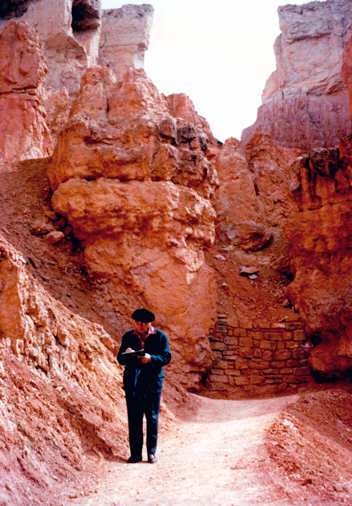Other Links
Editorial Board
- Editor - Bill Kenny
- London Editor-Melanie Eskenazi
- Founder - Len Mullenger
Google Site Search
SEEN
AND HEARD CONCERT REVIEW
Messiaen ,
From the Canyon to the Stars :
Pierre-Laurent Aimard, (piano),
Jean-Christophe Vervoitte (horn), Samuel Favre (xylophone),
Michel Cerruti (glockenspiel), Ensemble Intercontemporain, Susanna
Mälkki (conductor), Queen Elizabeth Hall, London, 2. 2.2008 (AO)

Olivier Messiaen at the Grand Canyon
Ensemble Intercontemporain was founded in 1976 by Pierre Boulez to
specialise in new music. Aimard was in fact one of the founder
members. Because its musicians are virtuosi in their own right,
the orchestra’s philosophy is well suited to Messiaen’s music,
where clarity of instrumentation matters so much. Each detail in
music like this needs to remain pure and distinct, not muddied.
Susanna Mälkki, the Ensemble’s new Music Director, is able to draw
out the best from her musicians while negotiating the complex
twists and turns that propel the trajectory.
This is no minor achievement. From the Canyons to the Stars
is two hours long, a series of 12 individual sections. It’s a
huge beast, but not a symphony in the traditional sense. Instead,
it’s a panorama of unfolding vistas. Bravely, Mälkki abandoned
the frequent practice of dividing the piece into two parts with an
interval. Yet, this performance didn’t sprawl into loose
confederation because she hard such firm grasp of its inner
dynamic Messiaen observed birds not only for their songs but in
their movements. Sometimes birds creep quietly on the ground, but
they can sudden fly off unpredictably. That’s how they survive.
“Man hasn’t
been on this earth that long”, Messiaen said. "Before us there
were prehistoric monsters, but in between there were birds".
Canyons, of course, are even more ancient than birds or dinosaurs,
so they represented for the composer a force even more primeval
and closer to his God. Conventional symphonies have an inner
architecture like a skeleton. Instead, Messiaen finds a different
kind of structure, more organically based on observation of
nature. Thus Mälkki
intuited that this music works with an exoskeleton, for it is
these jerky changes of direction, and sudden leaps from noise to
utter silence, give the music its overall shape. This was a
perceptive approach which made more sense than trying to fit it
into a more obvious “logical” form.
Without doubt,
Mälkki is someone to watch, and may become one of the more
outstanding conductors of this generation. Last summer, at the
Proms, conducting Boulez and Birtwistle, she showed similar
intelligence. When she conducted Boulez’s Dérive II she
brought out its surprisingly powerful, organic lyricism. It seemed
to unfurl like a fern, each cell growing out of another,
developing and expanding. Messiaen’s influence on Boulez is
deeper than commonly assumed.
The twelve sections of the work revealed themselves as a
progression. Each section is built up from myriad details.
Significantly, the smallest instrument in the orchestra, the
piccolo, plays an important role, just as the smallest bird in a
dawn chorus can be heard distinctively.
The third section, Ce qui est écrit sur les étoiles is
built around massive, angular blocks of sound. Before the
concert, Mälkki had spoken about the “shape” of Messiaen’s work
being as valuable as the colours, so often assumed to be the basis
of Messiaen’s music. The Ensemble produced blocks of sound,
reinforced by detail like the “geophone”, a flat drum filled with
lead beads, rotated to sound like shifting dunes of sand.
Although it’s very graphic, it fits in with the overall palette of
sound rather better than the famous wind machine. Similarly,
Mälkki understood the upright and downward thrusts in the music,
evoking the craggy peaks and columns in the strange geology that
is Bryce canyon, but also Messiaen’s spiritual aspirations.
Pierre-Laurent Aimard’s two long solos in the 4th and 9th
sections were beautifully executed. For a moment, time seems to
stand still, while the piano does a “display dance” like a bird
showing off its plumage, and then the music progresses back to its
normal pace.
Jean-Christophe Vervoitte’s horn solo was spectacular. Again, for
a moment, Messiaen takes a break from the landscape as a whole,
focussing on an individual. The elaborate horn seems to be calling
across the desert, across time and space itself. It doesn’t get a
reply, even when it repeats itself more quietly, as if from a
distance. However, this serves to emphasise the isolation of this
landscape, and perhaps, the realisation that there isn’t any need
for a response from another terrestrial party, when one is in the
presence of the sublime.
The final section, Zion Park et la cite céleste, evolves
naturally from what has gone before as dawn follows a peaceful
night filed with stars. There doesn’t “need” to be tension before
this glorious morning, for in nature, day naturally follows night,
eternally, regardless of what happens in the world. Struggle is a
“human” value but humans are irrelevant in this landscape. Hence
the dawn chorus imagery returns in glory.
Glockenspiel and
Xylophone are “dawn chorus” instruments par excellence, many
individual parts working in unison yet without blurring. The
ostinato angles in this section act like apostrophies urging the
music onwards, rather than interrupting the flow. The whole
ensemble joins in a riotous crescendo of unalloyed joy. What a
nice conclusion to the first part of this excellent South Bank
festival.
Anne
Ozorio
Picture courtesy of the South Bank Centre
Back
to Top
Cumulative Index Page
